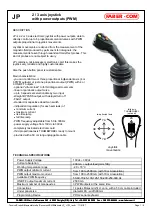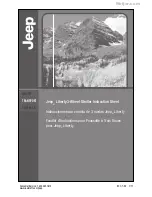
3DM683 Digital Stepping Driver Manual V1.0
Tel: +086 0755-26434369 9 Web Site: www.leadshine.com
the application needs a different standstill current, please contact Leadshine.
8. Wiring Notes
l
In order to improve anti-interference performance of the driver, it is recommended to use
twisted pair shield cable.
l
To prevent noise incurred in PUL/DIR signal, pulse/direction signal wires and motor wires
should not be tied up together. It is better to separate them by at least 10 cm, otherwise the
disturbing signals generated by motor will easily disturb pulse direction signals, causing motor
position error, system instability and other failures.
l
If a power supply serves several drivers, separately connecting the drivers is recommended
instead of daisy-chaining.
l
It is prohibited to pull and plug connector P2 while the driver is powered ON, because there is
high current flowing through motor coils (even when motor is at standstill). Pulling or plugging
connector P2 with power on will cause extremely high back-EMF voltage surge, which may
damage the driver.
9. Typical Connection
A complete stepping system should include stepping motor, stepping driver, power supply and
controller (pulse generator). A typical connection is shown as figure 9.
Figure 9: Typical connection
3DM683 Digital Stepping Driver Manual V1.0
Tel: +086 0755-26434369 10 Web Site: www.leadshine.com
10. Sequence Chart of Control Signals
In order to avoid some fault operations and deviations, PUL, DIR and ENA should abide by some
rules, shown as following diagram:
Figure 10: Sequence chart of control signals
Remark:
a)
t1: ENA must be ahead of DIR by at least 5
µ
s. Usually, ENA+ and ENA- are NC (not
connected). See
“
Connector P1 Configurations
”
for more information.
b)
t2: DIR must be ahead of PUL active edge by 5
µ
s to ensure correct direction;
c)
t3: Pulse width not less than 2.5
µ
s;
d)
t4: Low level width not less than 2.5
µ
s.
11. Protection Functions
To improve reliability, the driver incorporates some built-in protection functions. The 3DM683
uses one RED LED to indicate what protection has been activated. The periodic time of RED is 3
s (seconds), and how many times the RED turns on indicates what protection has been activated.
Because only one protection can be displayed by RED LED, so the driver will decide what error to
display according to their priorities. See the following
Protection Indications
table for displaying
priorities.
Over-current Protection
Over-current protection will be activated when continuous current exceeds the upper limit or in case
of short circuit between motor coils or between motor coil and ground, and RED LED will turn on
once within each periodic time (3 s).


































